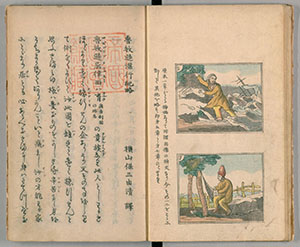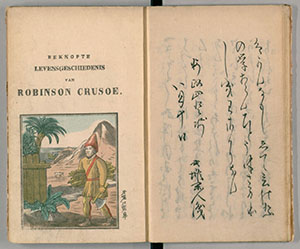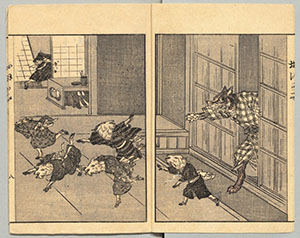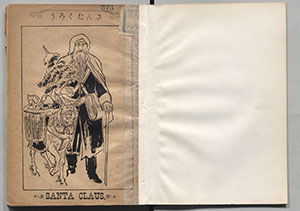70th Anniversary Commemorative Exhibit "A Treasure Box of Books - The 70-year History of the National Diet Library and Its Collections"
- A Treasure Box of Books
- Part 2 Diverse Collections
- Chapter 2 Books you might have seen somewhere
- Section 1 Popular with Children
Part 2 Chapter 2 Section 1 Popular with Children
This section exhibits fairy tales and manga, enjoyed by countless children. The first half of the section introduces old versions of fairy tales and fairy tale protagonists with names different from those they currently have. The second half features exhibits of images showing the first appearances of some manga characters which still remain popular today.
71 Robinson hyokokiryaku by Daniel Defoe, translated by YOKOYAMA Yoshikiyo, 1857 [199-258]
This exhibit material is a translation of The Life and Strange Surprising Adventures of Robinson Crusoe. It is said to be the first book to be translated in Japan for children. The original text was a Dutch language version. Kawakami Togai, who played a major role in much of the development of western painting in Japan during the Meiji Era, drew the illustrations for the work. The hat worn by Robinson Crusoe in the illustrations is very distinctive.
- Making things more familiar for children - Adaptation -
-
During the Meiji and Taisho Eras, "adaptations" were often carried out which changed the names of characters, etc. to more Japanese styles. For example, Santa Claus became "Santakuro", while Alice from Alice's Adventures in Wonderland became "Ai-chan". The exhibited material Ookami features a wolf and goats wearing traditional Japanese clothing. One can feel the kind intentions of the translators to make these works feel more familiar for Japanese children.
72 Andorusen katei monogatari narrative by UEDA Kazutoshi, edited by Shobido henshubu, Shobido, 1911 [329-94]
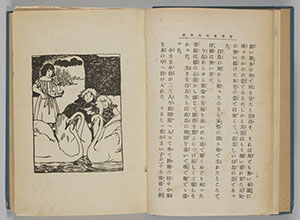
Enlarge Image
Digital Collections
The exhibited material is Andersen's Fairy Tales. It contains 25 tales including The Ugly Duckling retitled in Japanese as "Minikui Ahiru no Hina" (displayed section), Kasumi no Koromo (lit. "clothes of mist", English title "The Emperor's New Clothes"), and Tsukegi Uri (lit. "match seller", English title "The Little Match Girl"). Hashiguchi Goyo drew the beautiful illustrations, and the translation was provided by Ueda Kazutoshi, who established the foundation for modern Japanese national language studies.
73 Ookami by Grimm Wilhelm, translated by UEDA Kazutoshi, YOSHIKAWA hanshichi, 1889 [特67-390]
The exhibited material is the Grimms' Fairy Tales known as "The Wolf and the Seven Kids (original title: Der Wolf und die sieben jungen Geissiein)". The work features a unique interpretation with both the wolf and young goat characters wearing traditional Japanese clothing and living in a Japanese-style house.
74 Santakuro by SHINDO Nobuyoshi, Kyobunkan, 1900 [特45-90]
This exhibited material is said to be the first book in Japan containing a picture of Santa Claus. The main text refers to Santa Claus as "Hokukoku no oyaji Santakuro (lit. old man from the North Santakuro)".
75 Aichan no yume monogatari by Lewis Carroll, translated by MARUYAMA Eikan, Naigai Shuppan Kyokai, 1910 [32-441]
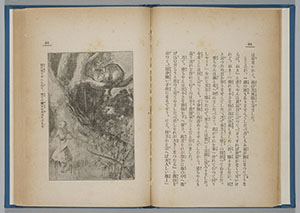 Enlarge Image
Enlarge Image
Digital Collections
The exhibited material is the first faithful translation of the entirety of the original text of Alice's Adventures in Wonderland. To make the story more suited to Japan, "Alice" is renamed "Ai-chan". The displayed section is the scene where Alice has a conversation with the Cheshire Cat.
76 Yuki no hi no Usakochan written and drawn by Dick Bruna, translated by ISHII Momoko, Fukuinkan Shoten, 1964 [Y17-28-[4]]
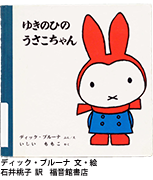
Miffy, still popular even today, was first introduced to Japan as "Usako-chan" in 1964 when it was translated into Japanese from its original Dutch version. Four Usako-chan books were published this year, a spring, summer, autumn, and winter volume, and the volume exhibited here is the winter volume. It features the adorable Usako-chan making preparations for winter.
77 Yureiikka hakaba no Kitaro by MIZUKI Shigeru
(Youkiden, 2, Togetsu Shobo, 1960 [Y16-3113])
Mizuki Shigeru's Kitaro series was introduced as the kamishibai (picture card show) Hakaba Kitaro in 1954. The first appearance of the character as a manga book was the kashihon manga Youkiden volume 1 which was sold in 1960. The exhibited material is the title page of Youkiden volume 2, Yureiikka hakaba no Kitaro.
- Kitaro's first appearance - Kashihon manga -
-
In the 1950's buying a book was a luxury, so there is kashihon-ya (rental book store). This also resulted in the existence of kashihon manga, which had a very unique flavor. Mizuki Shigeru's Kitaro introduced in this exhibition is also a character which began from kashihon manga. It was not just Mizuki either. A great number of manga artists who are still famous today made kashihon manga works, including Tezuka Osamu, Shirato Sanpei, and Umezu Kazuo.
78 Kodomo no ehon no. 10 Anpanman written and drawn by YANASE Takashi
(PHP, 1969 October Edition No. 257, PHP kenkyujo, October 1969 [Z23-140])
Yanase Takashi's Anpanman first appeared in PHP No. 257 in October 1969. At the time, the character’s face was not made of anpan (red bean jam buns) and he looked a little different than the present day Anpanman, but he was still a hero who worked for all of the troubled people around the world.
79 Tetsuwan Atom (Astro Boy) by TEZUKA Osamu
(Shonen, Volume 7 Number 4, Kobunsha, April 1952 [Z32-375])
Old favorite Tetsuwan Atom (Astro Boy) was active as a hero from this issue. The televising of the anime version also began in 1963. This was the first serial broadcast of a domestically produced TV animation.
80 Doraemon by Fujiko Fujio
(Shogaku Ichinensei, Volume 25 No. 11, Shogakukan, January 1970 [Z32-353])
81 Doraemon by Fujiko Fujio
(Shogaku Ninensei, Volume 25 No. 11, Shogakukan, January 1970 [Z32-359])
82 Doraemon by Fujiko Fujio
(Shogaku Sannensei, Volume 24 No. 10, Shogakukan, January 1970 [Z32-364])
83 Doraemon by Fujiko Fujio
(Shogaku Yonensei, Volume 48 No. 10, Shogakukan, January 1970 [Z32-372])
Serialization of Fujiko Fujio's Doraemon began in January 1970 with the 6 issues Yoiko, Shogakukan no Yochien, Shogaku Ichinensei, Shogaku Ninensei, Shogaku Sannensei, and Shogaku Yonensei. Each of the 6 issues featured a different story.
